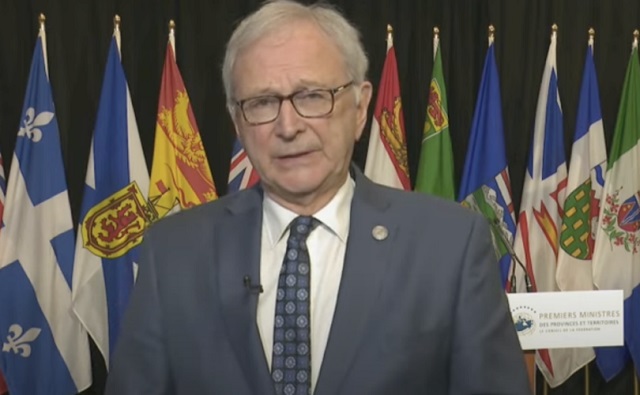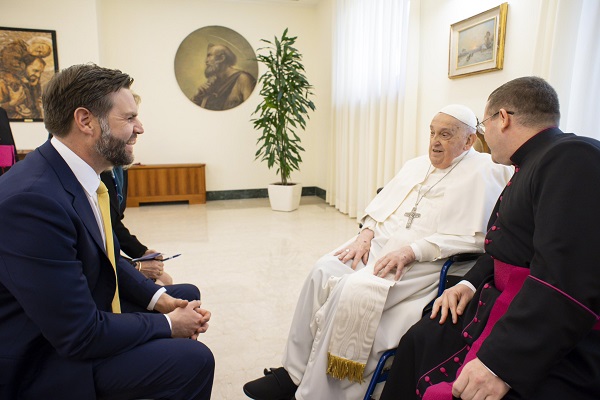Opinion
New Brunswick premier bans ‘sex-ed’ group from schools after presentation on porn, immoral sex acts

New Brunswick Premier Blaine Higgs
From LifeSiteNews
Sharing slides of a presentation given by a third-party group to New Brunswick school children that contained questions about pornography, masturbation and ‘anal’ sex, Premier Blaine Higgs said he is ‘furious’ and that the group has been banned, ‘effective immediately.’
Once again, New Brunswick Premier Blaine Higgs is showing Canadian politicians how to effectively advocate for common sense socially conservative policies. On May 24, he tweeted out a photograph of a slide from a sex education presentation given in a New Brunswick school. The slide featured red lips closing on a lollipop, the title “Thirsty For The Talk,” and the questions: “Is it normal to watch porn like people watch TV series?”; “Do girls masturbate?” and: “Is it good or bad to do anal?”
Premier Higgs posted his response:
A number of concerned parents have shared with me photos and screenshots of clearly inappropriate material that was presented recently in at least four New Brunswick high schools.
To say I am furious would be a gross understatement.
This presentation was not part of the New Brunswick curriculum and the content was not flagged for parents in advance. My office has been told by Department of Education officials that this was supposed to be a presentation on HPV.
However, the group shared materials well beyond the scope of an HPV presentation. The fact that this was shared shows either improper vetting was done, the group misrepresented the content they would share … or both.
This group will not be allowed to present again at New Brunswick schools, effective immediately.
Our government will have further discussions about whether additional rules about third-party presentations need to be updated.
Children should be protected, and parents should be respected.
I want parents to know that we are with you. We will continue to make decisions based on the principle that parents need to be aware of what is happening at schools, so they can make informed parenting decisions.
Do you think we need stronger rules about third-party presentations in our schools? I want to hear directly from you. Take our survey by clicking here:
Presentations like this – and indeed, presentations containing far more graphic material – are common in Canadian public schools. Plenty of schools actually feature in-house content that is substantially worse than this. But every time a debate about explicit, how-to sexual content in schools erupts, progressive activists and politicians dodge the issue by retreating to vagueness. Instead of defending the idea of an activist group like Planned Parenthood coming in to talk to students about why anal sex is just fine, they insist that this content is essential for “inclusion” and “tolerance” while scrupulously avoiding the specifics. Inevitably, most of the press coverage of the debate fails to include the specifics of what actually upset parents in the first place, and instead presents objectors as opposed to common sense progressive educational policies.
When the explicit content in question is described, however, progressives are denied the opportunity to defend their policy of encouraging and introducing fringe sex acts to children in vague, friendly, liberal-sounding buzzwords. Last year, for example, Planned Parenthood got caught handing out graphic “ABC” sex cards to students as young as 14 that explained, for example, how they could engage in “yellow and brown showers” (urinating and defecating on their partners). Plenty of other dangerous and immoral sex acts are encouraged, with Planned Parenthood’s presentation stating that each sexual urge must be “affirmed” – the amorality, in short, was up front.
But when the sex cards were covered in a handful of press outlets, parents were outraged the Saskatchewan government got involved. Planned Parenthood is now banned from presenting in Saskatchewan schools (although it was never explained why they were invited to do so in the first place). Planned Parenthood was reportedly confused by this decision, as they didn’t see the problem with the content they had distributed – but the only reason they were denied access to Canadian kids is because the graphic sexual information they were distributing was exposed publicly.
Premier Blaine Higgs appears to have realized that to implement common sense policies, exposing what is actually being taught in public schools is the only way forward. Progressives cannot be allowed to hide behind buzzwords like “toleration” and “inclusion.” Politicians and activists – including the prime minister – who wish to defend this content should be made to defend specifics, and the only way to force them to do that is to show the public what the kids are being taught in schools.
Business
Trump: China’s tariffs to “come down substantially” after negotiations with Xi

 MxM News
MxM News
Quick Hit:
President Trump said the 145% tariff rate on Chinese imports will drop significantly once a deal is struck with Chinese President Xi Jinping, expressing confidence that a new agreement is on the horizon.
Key Details:
- Trump said the current 145% tariff rate on China “won’t be anywhere near that high” after negotiations.
- He pointed to his relationship with Xi Jinping as a reason for optimism.
- The White House said it is preparing the groundwork for a deal, and Treasury officials expect a “de-escalation” of the trade war.
Diving Deeper:
President Donald Trump on Tuesday told reporters that the steep tariff rate currently imposed on Chinese imports will come down substantially after his administration finalizes a new trade deal with Chinese President Xi Jinping. While the current level stands at 145%, Trump made clear that number was temporary and would be adjusted following talks with Beijing.
“145 percent is very high. It won’t be that high, it’s not going to be that high … it won’t be anywhere near that high,” Trump said from the Oval Office, signaling a shift once a bilateral agreement is reached. “It will come down substantially, but it won’t be zero.”
The tariff, which Trump previously described as “reciprocal,” was maintained on China even after he delayed similar penalties on other trading partners. Those were cut to 10% and paused for 90 days to allow room for further negotiation.
“We’re going to be very nice. They’re going to be very nice, and we’ll see what happens. But ultimately, they have to make a deal because otherwise they’re not going to be able to deal in the United States,” Trump said, reinforcing his view that the U.S. holds the leverage.
Trump’s remarks come as markets remain wary of ongoing trade tensions, though the White House signaled progress, saying it is “setting the stage for a deal with China.” The president cited his personal rapport with Xi Jinping as a key factor in his confidence that an agreement can be reached.
“China was taking us for a ride, and it’s not going to happen,” Trump said. “They would make billions a year off us and build up their military with our money. That’s over. But we’ll still be good to China, and I think we’ll work together.”
Treasury Secretary Scott Bessent also said Tuesday that he expects a cooling of trade hostilities between the two nations, according to several reports from a private meeting with investors.
As the 90-day pause on other reciprocal tariffs nears its end, Trump emphasized that his team is prepared to finalize deals quickly. “We’ve been in talks with many, many world leaders,” he said, expressing confidence that talks will “go pretty quickly.”
White House Press Secretary Karoline Leavitt added that the administration has received 18 formal proposals from other countries engaged in trade negotiations, another sign that momentum is building behind Trump’s broader push to restructure global trade in favor of American workers and businesses.
(Li Xueren/Xinhua via AP)
2025 Federal Election
Canada’s press tries to turn the gender debate into a non-issue, pretend it’s not happening

From LifeSiteNews
When a conservative reporter asked Mark Carney how many genders there are and the prime minister gave an evasive answer, liberal journalists considered the question inappropriate because they want to control the narrative.
By any traditional journalistic standard, the reconstitution of reality by transgender ideology is one of the biggest stories of our generation. Indeed, in the middle of the Canadian election campaign, the UK Supreme Court ruled that “transwomen” are not women, triggering a massive backlash from the transgender movement and widespread celebration from those still possessed of common sense.
In Canada, however, the press — with the exception of the National Post and several independent outlets — has more or less collectively agreed to ignore the topic and to treat the matter as if it is settled. The mainstream broadsheets simply assume the validity of gender ideology and the social victory of the transgender movement regardless of the debates raging across the Western world.
Thus, when Alex Zoltan of Juno News managed to ask Prime Minister Mark Carney a question after the French debate, he touched a topic the rest of the media was avoiding like the plague: “How many genders are there?”
This is obviously a relevant question, with direct relevance to government policy. Current government guidelines state that gender is distinct from sex, and the Trudeau government introduced a non-binary gender option (“X”) for passports and other federal documents. Government missives have consistently referred to recently invented identities such as “two-spirit,” and last year Justin Trudeau explicitly stated that “transwomen are women” — on International Women’s Day (the UK Supreme Court disagrees).
Zoltan’s question was simple: “How many genders are there?”
In Mark Carney's Canada, stopping men from going into women's rape shelters is only a "general objective." pic.twitter.com/qJNqaBMUpt
— Alex Zoltan (@AmazingZoltan) April 20, 2025
Carney was uncomfortable but obviously prepared for the question. “Uhhhh … in terms of sex, there are two. Thank you.”
Zoltan: “My follow-up question then. Do you believe that women, biological women, have the right to their own spaces, their own sports, their own changerooms, their own prisons, their own homeless shelters?”
Here, Carney vacillated. The policy of the Trudeau government has been to segregate based on “gender” rather than biological sex. “This is Canada,” Carney stated obviously. “Um, and, um, ah, as a general objective, yes, but we work where we value all Canadians for who they are and we’ll continue to do so. Thank you very much.” In short: Carney performed a neat, albeit stumbling, pivot. He affirmed two sexes — as Pierre Poilievre has — but also appeared to affirm the Trudeau government’s transgender policies.
It is safe to assume that Carney, who has an adult daughter who identifies as non-binary, will not roll back any of Trudeau’s transgender policies, although he will likely be less performative about his LGBT activism. But what was as notable as his response to the question was the Canadian establishment’s reaction. Despite the fact that Zoltan’s question was incredibly relevant, they immediately responded as if only a fringe extremist would bother to touch on an issue so miniscule as the radical overhaul of our laws by a radical movement.
From the CBC:
True North dared ask Mark Carney if women deserve sex-based spaces, and the establishment is LIVID.
CBC cries it’s “unrelated to the debate.” 😢
They are desperate to control the narrative AND big cowards for not asking such a basic question already.pic.twitter.com/AhZmbKFlvE
— Cosmin Dzsurdzsa (@cosminDZS) April 17, 2025
The CBC complained that the topic was “unrelated to the debate.” Of course, the mainstream press has appointed itself the gatekeepers of which topics get covered, and transgender ideology has been ruled off-limits — which is why the state broadcaster would not even cover the UK’s Cass Review, which condemned the “gender-affirming care” so enthusiastically defended by the CBC and other outlets.
Journalist Wyatt Sharpe claimed the question was “American,” somehow — as if Canada has not been out front on these issues: “How many Canadians genuinely care about ‘how many genders there are?’… that is the type of American culture war style question that True North, Rebel, etc were hoping to cause Mr. Carney to not be able to answer. He answered it fine, and that’s why True North and Rebel haven’t been posting the question like they usually would across social media.”
The quintessential response came from David Beaudoin: “True North finally makes it on prime time. We’re in a trade war with the U.S. The economy is in peril. Here is a world-renowned economist running for Prime Minister. Time to show Canadians you’re a serious news outlet. ‘How many genders are there?’”
The message is clear. Men in women’s prisons? Men in female spaces? Women getting sexually assaulted by men in women’s shelters? Girls getting double mastectomies? Children getting socially transitioned by public schools without the knowledge of their parents, an issue taken up by several provinces (one of which used the notwithstanding clause to stop it)? The mainstream press has ruled from on high: Not real issues.
So, to all the women and girls and parents concerned about these issues: Shut up, they explained.
-

 2025 Federal Election1 day ago
2025 Federal Election1 day agoOttawa Confirms China interfering with 2025 federal election: Beijing Seeks to Block Joe Tay’s Election
-

 International2 days ago
International2 days agoPope Francis Dies on Day after Easter
-

 International2 days ago
International2 days agoJD Vance was one of the last people to meet Pope Francis
-

 COVID-191 day ago
COVID-191 day agoNearly Half of “COVID-19 Deaths” Were Not Due to COVID-19 – Scientific Reports Journal
-

 2025 Federal Election1 day ago
2025 Federal Election1 day agoHow Canada’s Mainstream Media Lost the Public Trust
-

 2025 Federal Election24 hours ago
2025 Federal Election24 hours agoBREAKING: THE FEDERAL BRIEF THAT SHOULD SINK CARNEY
-

 2025 Federal Election1 day ago
2025 Federal Election1 day agoReal Homes vs. Modular Shoeboxes: The Housing Battle Between Poilievre and Carney
-

 International13 hours ago
International13 hours agoNew York Times publishes chilling new justification for assisted suicide








